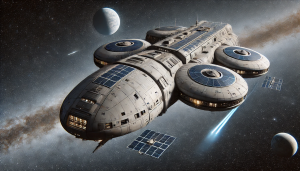The Solaris-Class Freighter

Solaris-Class Freighter
The Solaris-Class Freighter is a specialized, large-scale cargo vessel designed to transport goods and resources within a single solar system. Unlike its deep-space counterparts, the Solaris-Class is optimized for shorter, high-frequency trips between planets, moons, and space stations. Known for its agility, adaptability, and capacity, this freighter model forms the backbone of intrastellar logistics, maintaining steady flows of materials, equipment, and supplies between worlds and installations.
Design and Specifications
The Solaris-Class Freighter is built for efficiency and durability, with a more compact design than interstellar freighters. The ship spans approximately 1 kilometer in length and has a streamlined, modular structure that prioritizes quick loading and unloading. It features reinforced cargo holds and uses a highly energy-efficient propulsion system to conserve resources during constant use.
- Primary Propulsion: Equipped with Solar Ion Drives for efficient and rapid movement within solar systems. These drives harness solar energy from nearby stars, reducing fuel consumption and allowing for high-frequency travel. - Cargo Capacity: Capable of carrying up to 1 million cubic meters of cargo, including raw materials, refined metals, food supplies, and heavy machinery. - Navigational Systems: The Solaris-Class is equipped with an Automated Intrastellar Navigation Suite that optimizes routes between planetary bodies, using gravitational assists to reduce travel time and energy consumption. - Reinforced Cargo Bays: Solaris-Class freighters feature multiple cargo bays with modular divisions, allowing for efficient compartmentalization of different types of goods, from fragile supplies to industrial-grade materials. - Crew: Operated by a small team of 10 to 20 crew members, including navigation officers, cargo specialists, and maintenance personnel, the Solaris-Class can operate autonomously for extended periods.
Notable Ship: The Helios Runner
A prominent vessel within the Solaris-Class fleet is the Helios Runner, operated by the Helios Transport Consortium, a company that specializes in rapid goods distribution within densely populated solar systems. The *Helios Runner* has a reputation for reliability and speed, maintaining precise schedules even in crowded orbital paths.
Key modifications on the Helios Runner include: - Enhanced Radiation Shielding: With reinforced shielding for transporting sensitive cargo closer to high-radiation environments, such as planets with intense magnetic fields or close to solar flares. - Automated Loading Drones: The *Helios Runner* features automated drones for rapid loading and unloading, allowing for short turnaround times. - Dedicated Passenger Modules: Modified to carry passengers on short planetary runs, the *Helios Runner* has a module with secure cabins and life support for temporary personnel.
Role in Intrasolar Trade
Solaris-Class Freighters play a critical role in maintaining stable economies and trade within solar systems. These vessels connect major planets, moons, and orbital installations with essential goods, supporting industries ranging from mining and manufacturing to agriculture and scientific research. Due to their agility and frequent journeys, Solaris-Class freighters form the logistical lifelines of heavily populated solar systems.
Unique Structural Features
Built to accommodate frequent and flexible transport needs, the Solaris-Class Freighter incorporates several design elements tailored to intrasolar operations:
- Modular Docking Ports: Quick-docking systems allow for efficient loading and unloading at a wide range of spaceports and stations. - Energy Shields: Basic shielding for protection from space debris and minor impacts, ensuring structural integrity over extended use. - Solar Array Collectors: Large, retractable solar arrays gather energy for propulsion, reducing fuel dependence and enhancing operational efficiency during prolonged voyages within a star's orbit.
Cultural Significance
Due to their regular and visible presence within solar systems, Solaris-Class Freighters are familiar sights for spaceport personnel and planetary inhabitants. Often regarded as dependable, everyday heroes of intrastellar logistics, Solaris-Class Freighters are celebrated for their role in keeping goods, supplies, and personnel moving smoothly. Some Solaris freighters even become beloved local fixtures, recognized by their distinctive paintwork or patterns as they make routine stops across the solar system.
Strategic Importance
During times of planetary crisis or shortages, Solaris-Class Freighters can be rapidly mobilized to deliver essential resources. They are critical to planetary defense logistics, capable of transporting large quantities of fuel, medical supplies, and repair parts to stations or defense satellites. Their reliability and short-range capacity make Solaris-Class Freighters integral to the sustainability and security of solar system inhabitants.
Future Prospects
As solar systems develop more advanced infrastructure, Solaris-Class Freighters are expected to evolve with upgraded solar energy capabilities, enhanced autonomous navigation, and increased cargo adaptability for specialized needs. Given their cost efficiency and ease of deployment, these freighters are anticipated to remain a staple of intrasolar trade and logistics well into the future.
